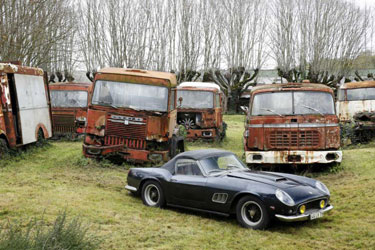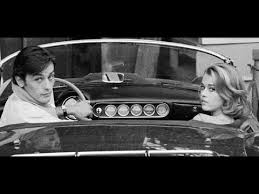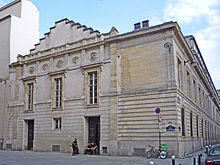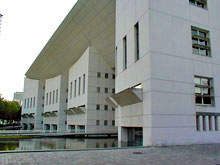 |
| The Independent Traveler's Newsletter PAGE FIVE |
 |
| The Independent Traveler's Newsletter PAGE FIVE |
| THE 2015 TOUR DE FRANCE: Will you be along the route? | |
|
For anyone interested in bed &
breakfast accommodations at selected points along the
route, the list
below
might be helpful. Lodging will become scarce, so if you are
interested in any of them, please use the contact information soon to
check availability. Driving times are given.
VINTAGE CAR
TREASURES: Once in a lifetime discovery
western France sold at auction   The 1961 Ferrari
California Spyder now and then - with Alain Delon and
Jane Fonda in movie Les Felins (1964) Classic car enthusiasts must be
beside themselves about the news in December that 60 vintage cars were
discovered in western France by Matthieu Lamoure and Pierre Novikoff of
the Artcurial Motorcars auction house - in horrific condition in a
dilapidated old barn and some other makeshift structures. Left
alone since they were brought to the farm between 1955 and 1965, the
cars were exposed to the elements and to nature, some with plants
growing in and around them! The collector who so casually stored
them was Roger Baillon, a transport mogul, who sold off 50 cars of the
collection in the 1970s.
The two men came to the location
after hearing rumors about the cars, never expecting to find more than
a few old relics. What they rescued from this 'graveyard'
includes
a Talbot Lago T26s once the property of Egypt's King Farouk, a Bugatti
and a Maserati among dozens and dozens even more rare vehicles.
Many have said that this is the find of the century. An auction of the vehicles took
place at the Retromobile Salon on February 6th, and each car that sold
(only 20 were unsold or withdrawn from the auction) was in 'as
is' condition. The one car in presentable condition was a 1961
Ferrari California Spyder once owned by actor Alain Delon and one of
only 37 made, and it was estimated that it would fetch €12
million. But, it actually was sold for €16,298,000, the
highest price paid for any automobile in the Baillon collection! The
total received at the Retromobile Salon auction in Paris for all of
Baillon's
cars was €25.15
million.
[Photos by Remi Dargegen were taken before
the site was disturbed in any way.]
CLASSICAL MUSIC IN PARIS:
Some High Spots and Highjinks
by Arthur Gillette
The National French Opéra
was
created in 1669, and its performances tended to take place at the
Versailles Royal
Court. But Paris Ville has also long hosted classical
music
creations and public performances. Anecdotes linked to the people and
places
concerned make for a somewhat wry understanding of the mainly 19th
century classical musical life of the French capital.
To be sure, not everything was light and fluffy. The heavy-duty four hour premiere of Rossini's William Tell (remember the Lone
Ranger signature theme?) in 1829 signed that composer's decline, for
example. In contrast, the Parisian classical music scene also saw
lots of surprises, fun and games. A few examples . . . Le Style Napoléon III
When the Théâtre des
Italiens (now
Opéra Comique) was built at the end of the 17th century, its
main entrance was placed on the modest Place Boiledieu instead of, as
expected, the major artery that came to be known as the Boulevard des
Italiens. This caused a wag to rhyme: Dès le premier coup d'oeil on
reconnait très bien [translated: At first glance one can
see clearly that the new theatre is all Italian because it is laid out
in such a way as to present to passersby its ... backside!) Another music-architecture laugh
came when the Second Empire Paris Prefect (governor) Haussmann ran a
competition to design the new opera house after Napoléon III
narrowly
escaped
assassination on leaving the badly congested old one. A young architect named
Charles Garnier, with little more under his belt than an internship
with Notre
Dame restorer Viollet le Duc, won. But his ornate project – later
dubbed 'an
overloaded sideboard' – still had to be approved by Empress
Eugénie, a Spaniard
who envied the broad boulevards and glitzy new buildings of Victorian
London. "Pray tell me, Monsieur," she
admonished Garnier when he presented the design to her, and puckering
her lips in near disgust, "what on earth is this style?" A quick thinker (and realizing that
his professional head was on the line), Garnier shot back out of whole
cloth, "Why, Sire, it's le Style Napoléon III!" "Ah, sighed the Empress, relieved,
"that's all right then. I can sign."
The Avenue de l'Opéra is the
only of Haussmann's broad Parisian boulevards devoid of trees, left so
on purpose still today to enable admiration of, at its upper end, the
recently restored 'sideboard' it took Garnier fourteen years to
complete. Modulate, modulate! An international Mecca practically
from its creation in 1795 for often very young and talented pupils
(Saint-Saëns entered at eleven years, Debussy was ten!), the
National Conservatory of Music and Declamation (i.e., drama) was the
scene of more than one humorous run-in. Its early 19th century Director
enforced a rule against allowing matriculation of non-French. How
Belgian César Franck managed to sneak in, I haven't been able to
discover. But, the answer to Hungarian Ference (Franz) Liszt was
an irrevocable non! The
kicker is that the Director in question was Luigi Cherubini, who
happened to be Italian. The kicker to the kicker is that Liszt's
parents retaliated by renting a Paris concert hall for what was a
runaway success by their son, who probably didn't regret not having to
suffer through endless course work and boring practice at the
Conservatory.  
The
former and the current National Conservatory of Music,
Paris
Hector
Berlioz was looked on as
such
a renegade when studying at the Conservatory that his work wasn't
performed
there; and a plaque honoring him was only unveiled there in 2003!
Tradition
and innovation certainly vied regularly between these august walls.
When
Gabriel Fauré became Director of the Conservatory in 1905, he
undertook
strenuous reforms that earned him the nickname 'Robespierre.' Teaching a Conservatory piano
course,
César Franck once shouted a young Claude Debussy, "Modulate,
modulate!" "Why?" retorted Debussy, "I'm quite
happy where I am." Another instructor commented to
student Debussy, "I'm not saying that what you write isn't pretty, but
it's theoretically absurd." "Just listen to me play," came the
answer, "There is no theory; pleasure is the only law."
Another exchange of niceties came between Debussy and up-and-coming
whimsical innovator Eric Satie. Taunted Satie on one occasion, "Maître Debussy has always
refused the Legion of Honor, but all his music has always accepted
it!" Fact of the matter is that, under pressure from his parents,
Debussy did accept the Legion of Honor, which didn't prevent him from
orchestrating Satie's piano-scored Gymnopédie.
The 19th century Paris classical scene brought music into the modern epoch. Consider Jacques Offenbach: his early works, such as Orpheus in the Underworld and La Belle Hélène, drew on Greek mythology, perhaps partly to disguise his critique of contemporary mores and thus avoid the censor's heavy hand. His later La Vie Parisienne is right up to date, however it opens in a train station! And Bizet's Carmen begins outside a cigarette factory, while Darius Milhaud's Ox on the Roof is set an an American-style bar with a black barkeep! Could have been 2014! Contact
Arthur
Gillette to take advantage of his amazing knowledge of Paris
by enjoying one or more of his Paris Through the Ages Strolls. Visit our Marketplace page for a complete list of strolls and information about Arthur. Email: pouchkine38@gmail.com
DISCLAIMER: You have received this newsletter because your email address is on our Opt-In mailing list, i.e., you have requested to receive FRANCE On Your Own ©. If you would like to discontinue receipt of this newsletter, please send an email to publisher@franceonyourown.com with "unsubscribe" on the Subject line. Unless indicated otherwise, photos, graphics, artwork and text in the FRANCE On Your Own © newsletter are all the property of Cold Spring Press and FRANCE On Your Own © and cannot be copied, duplicated or used in any manner by anyone without the express written permission of Cold Spring Press. FRANCE On Your Own © is published online by Cold Spring Press, P O Box 26098, San Diego, California 92196-0098. This publication is copyrighted and no portions of the text, artwork, graphics or photographs may be reproduced or distributed in any form or by any means or stored in a database or retrieval system without the written permission of the Publisher. For more information about FRANCE On Your Own ©, visit our web site at http://www.franceonyourown.com. Recommendations made in this newsletter are based upon the personal experiences of the Publishers or contributing writers solely to provide information to subscribers. Cold Spring Press and FRANCE On Your Own © make no endorsements nor are any guarantees or promises of satisfaction given or implied. Any and all information is correct to the best of our knowledge, and the Publishers accept no responsibility for errors and/or omissions. The responsibility lies entirely with the traveler to obtain current information regarding accommodations, availability, schedules, prices, reservations, or any other pertinent details. We do not guarantee the historical accuracy of the contents of articles in this newsletter. Historical accuracy is dependent upon one's sources of information -- and contradictions often exist among those sources. Links to other web sites or email addresses are provided for informational purposes only and do not imply any guarantees of service or endorsement of any organization or their business practices. FRANCE On Your Own © is electronically transmitted via email. To add your email address to our database for this FREE newsletter, send an email to info@franceonyourown.com, and please put Subscribe in the subject line. We do not share email addresses with any other organization. BACK ISSUES of the print version of FRANCE On Your Own © and Free online back issues are available on our web site at http://www.franceonyourown.com/Archives.htm. ©1998-2015
Cold Spring Press All Rights Reserved |
|
 previous
page
previous
page |